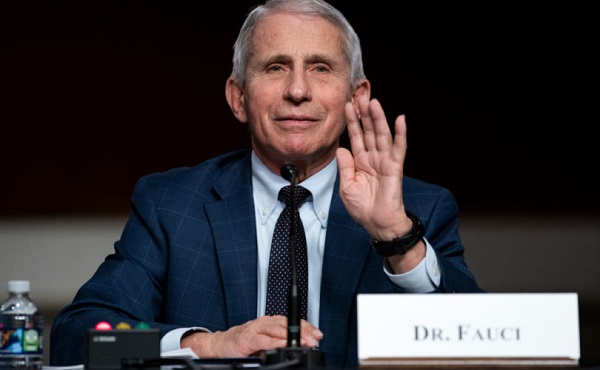COVID-19
‘That Science Should Not Have Been Done’: Former CDC Director Compares Fauci To Oppenheimer


From the Daily Caller News Foundation
By Mariane Angela
Former Centers for Disease Control and Prevention Director Dr. Robert Redfield appeared Wednesday on Newsmax to discuss Dr. Anthony Fauci’s preemptive pardon by former President Joe Biden.
“I hope that it gives Fauci an opportunity to try to be more honest and transparent about the decisions that he made and what he did. I’m not confident that that’s going to happen,” Redfield said during an appearance on “Rob Schmitt Tonight.”
“You know, I also think it’s odd for Biden to pardon him prospectively when he hasn’t been accused of any direct crime. I know if I was in that position that I wouldn’t like that because it does imply that I actually did something wrong.”

Former CDC Director Dr. Robert Redfield appeared Wednesday on Newsmax to discuss Dr. Anthony Fauci’s preemptive pardon
Redfield also talked about events portrayed in the 2023 film “Oppenheimer.”
The former director said he hopes — similar to J. Robert Oppenheimer’s eventual realization of his impact on global warfare — Fauci might come to terms with the ramifications of his decisions before and during the pandemic.
“You know, when I watched the ‘Oppenheimer’ movie and I watched the scenes when Oppenheimer finally realized what happened with the science that he gave to the world, particularly when President Truman decided to use the atomic bomb a second time, and he realized that he had opened up really a big problem in terms of giving science to create a weapon that could kill hundreds of thousands of people. I don’t know if Tony realizes, and he’s very sensitive to this issue,” Redfield said when asked if Fauci recognized his responsibility.
Redfield said he wonders whether Fauci acknowledges the full extent of his actions, particularly what Redfield said was Fauci’s role in funding gain-of-function research.
“I do think Tony did mislead the nation, and he did mislead the Congress. He did make some bad decisions when it came to funding the research and gain-of-function research in China,” Redfield said.
Redfield said he hopes Fauci would act transparent and accountable in his actions.
“I think it’s really important. If one good thing comes from this is we get a moratorium on gain-of-function research. I do hope Tony takes advantage of this opportunity to basically be more transparent and let people understand why he made the decisions he did and also admit some accountability for the negative consequences of those decisions,” Redfield said, adding “that [that] science should not have been done.”
During the last hours of his presidency on Monday, Biden issued preemptive pardons to Fauci, Gen. Mark Milley, and the members of the Jan. 6 committee and said that they should not be subjected to “unjustified and politically motivated prosecutions.” The pardon spans back to 2014, encompassing Fauci’s role on the White House Coronavirus Task Force and his position as the chief medical advisor to Biden.
Accusations against Fauci include lying to Congress and circumventing requests under the Freedom of Information Act. Fauci has consistently described COVID-19 as a “natural occurrence” and denied any link between his agency’s subawards to the Wuhan Institute of Virology and the origins of the virus. Several experts have accused Fauci of committing perjury during his congressional testimonies, particularly in his denials that the viruses he supported could have evolved into COVID-19.
COVID-19
Spy Agencies Cozied Up To Wuhan Virologist Before Lying About Pandemic


From the Daily Caller News Foundation
By Emily Kopp
The Office of the Director of National Intelligence’s (ODNI) hub for foreign biological threats dismissed the intelligence pointing to a lab accident in Wuhan as “misinformation” in January 2021, two former government sources who requested anonymity to discuss sensitive internal meetings told the Daily Caller News Foundation. New documents show that intelligence risked implicating ODNI’s own bioengineering advisor — University of North Carolina professor Ralph Baric.
Baric, who engineered novel coronaviruses with the Wuhan Institute of Virology (WIV), advised ODNI four times a year on biological threats, according to documents released Oct. 30 by Kentucky Sen. Rand Paul.
Dear Readers:
As a nonprofit, we are dependent on the generosity of our readers. \
Please consider making a small donation of any amount here.
Thank you!
Baric did not respond to the DCNF’s requests for comment.
The professor’s ties to American intelligence may run even deeper, the documents reveal, as ODNI facilitated a meeting between the CIA and Baric about a project on coronaviruses in September 2015.
The email exchange with the subject line “Request for Your Expertise” shows an unnamed government official with a CIA-affiliated email address pitching a “possible project” to Baric relating to “[c]oronavirus evolution and possible natural human adaptation.”
The new documents shed a bit of light on a question members of Congress have posed for years: Whether our own intelligence agencies knew more about the likelihood of a lab origin of COVID than they told the public.
“Director Ratcliffe has been on the forefront of this issue since the start of the COVID-19 pandemic and has been committed to transparency and accountability on this issue,” a CIA spokesperson said in a statement. “In January – as one of the Director’s first actions at Langley – CIA made public its assessment that a research-related origin of the COVID-19 pandemic is more likely than a natural origin. CIA will continue to evaluate any available credible new intelligence reporting as appropriate.”
Paul is seeking more documents from ODNI on potential ties between U.S. intelligence and the research in Wuhan as part of an ongoing investigation by the Senate Committee on Homeland Security and Governmental Affairs and has promised public hearings in the coming months.
Director of National Intelligence (DNI) Tulsi Gabbard disbanded the ODNI biological threats office earlier this year following questions from the DCNF about its suppression of COVID origins intelligence in August. Gabbard and a dedicated working group have also been quietly investigating the origins of COVID.
Protecting Their Own

Baric gave a presentation to the ODNI in January 2020 showing that he advised American intelligence that COVID may have emerged from a lab, the documents also indicate. Baric shared that the WIV had sequenced thousands of SARS-like coronaviruses, including strains capable of epidemics, the slides show.

Baric noted that the Wuhan lab does this work under low biosafety levels despite the ability of some of these viruses to infect and grow in human lung cells.
What Baric omitted: He had submitted a grant application in 2018 with intentions to conduct research to make coronaviruses with the same rare features seen in COVID while concealing the Wuhan lab’s low biosafety level, jotting in the margins of a draft of the grant application that Americans would “freak out” if they knew about the shoddy standards.
One year after Baric’s presentation, ODNI had hardened against the lab leak hypothesis.
When State Department officials pushed to declassify certain intelligence related to a plausible lab leak in January 2021, the ODNI expressed concerns that it would “call out actions that we ourselves are doing.”
Former ODNI National Counterproliferation and Biosecurity Center (NCBC) Director Kathryn Brinsfield, a medical doctor, also dismissed a January 2021 presentation by government officials about a plausible lab origin of COVID as “misinformation,” two sources told the DCNF. Her top aide Zach Bernstein, who possesses a master’s degree in security studies but no scientific credentials, also dismissed the presentation, according to three sources.
Gabbard disbanded NCBC in August following questions from the DCNF about its role in suppressing COVID origins intelligence.
But in the years preceding Gabbard’s takeover of the intelligence community’s central office, the ODNI’s public reports omitted any analysis of COVID’s viral genome. One intelligence agency filed a formal complaint about this glaring omission, the DCNF reported.
Scientists often received fierce pushback from former National Intelligence Council official Adrienne Keen, who helped steward former President Joe Biden’s 90-day review into COVID’s origins, an official told the DCNF. Paul’s request for records from ODNI includes a request for some of Keen’s communications.
Brinsfield and Keen did not respond to requests for comment.
Unanswered Questions
Despite the new disclosures, the precise nature of the CIA’s interest in Baric’s coronavirus work remains unknown. The documents do not include any further details about the work that the CIA and Baric may or may not have undertaken.
The U.S. Agency for International Development (USAID) funded the discovery of novel coronaviruses and shipped the samples to Wuhan through a 2009-2020 program called PREDICT, the DCNF reported in July. USAID sometimes acted as a CIA front before Trump dismantled it earlier this year — but no evidence exists that the CIA directed PREDICT.
An unnamed FBI special agent was in communication with Baric about responding to public requests for his research and emails with the Wuhan lab through the North Carolina Freedom of Information Act, according to a 2024 congressional letter, but details about the contact between the FBI and Baric also remain uncertain.
The CIA was slow to acknowledge that a lab was the pandemic’s most likely source, an assessment that the CIA made public more than five years after the pandemic emerged and well after the FBI and the Department of Energy.
In early 2020, when Trump’s Deputy National Security Advisor Matt Pottinger tasked CIA analysts to dig into the matter, they came up empty, according to a New York Times report. Instead, anonymous sources smeared Pottinger as having a “conspiratorial view” of the Chinese Communist Party.
Trump’s current CIA Director John Ratcliffe, who served as the DNI from May 2020 to January 2021, revealed in a 2023 Wall Street Journal op-ed that he had pushed for the declassification of COVID origins intelligence as the DNI but that he “faced constant opposition, particularly from Langley.”
COVID-19
Crown still working to put Lich and Barber in jail

From LifeSiteNews
The Crown’s appeal claims the judge made a mistake in her verdict on the intimidation charges, and also in how she treated aggravating and mitigating factors regarding sentencing.
Government lawyers for the Crown have filed an appeal the acquittals of Freedom Convoy leaders Tamara Lich and Chris Barber on intimidation charges.
The Crown also wants their recent 18-month conditional sentence on mischief charges replaced with harsher penalties, which could include possible jail time.
According to the Justice Centre for Constitutional Freedoms (JCCF), it is “asking the Ontario Court of Appeal to enter a conviction on the intimidation charge or order a new trial on that count,” for Barber’s charges.
Specifically, the Crown’s appeal claims that the judge made a mistake in her verdict on the intimidation charges, and also in how she treated aggravating and mitigating factors regarding sentencing.
As reported by LifeSiteNews, both Lich and Barber have filed appeals of their own against their house arrest sentences, arguing that the trial judge did not correctly apply the law on their mischief charges.
Barber’s lawyer, Diane Magas, said that her client “relied in good faith on police and court direction during the protest. The principles of fairness and justice require that citizens not be punished for following the advice of authorities. We look forward to presenting our arguments before the Court.”
On October 7, Ontario Court Justice Heather Perkins-McVey sentenced Lich and Chris Barber to 18 months’ house arrest after being convicted earlier in the year of “mischief.”
Lich was given 18 months less time already spent in custody, amounting to 15 1/2 months.
Lich and Barber were declared guilty of mischief for their roles as leaders of the protest against COVID mandates in April 2022, and as social media influencers. The conviction came after a nearly two-year trial despite the non-violent nature of the popular movement.
The Lich and Barber trial concluded in September 2024, more than a year after it began. It was originally scheduled to last 16 days.
As reported by LifeSiteNews, the Canadian government was hoping to put Lich in jail for no less than seven years and Barber for eight years.
LifeSiteNews recently reported that Lich detailed her restrictive house arrest conditions, revealing she is “not” able to leave her house or even pick up her grandchildren from school without permission from the state.
As reported by LifeSiteNews, Lich, reflecting on her recent house arrest verdict, said she has no “remorse” and will not “apologize” for leading a movement that demanded an end to all COVID mandates.
-

 armed forces1 day ago
armed forces1 day agoIt’s time for Canada to remember, the heroes of Kapyong
-

 Daily Caller2 days ago
Daily Caller2 days agoMcKinsey outlook for 2025 sharply adjusts prior projections, predicting fossil fuels will dominate well after 2050
-

 Business2 days ago
Business2 days agoTrump: Americans to receive $2,000 each from tariff revenue
-

 Business1 day ago
Business1 day agoCarney’s Floor-Crossing Campaign. A Media-Staged Bid for Majority Rule That Erodes Democracy While Beijing Hovers
-

 Housing2 days ago
Housing2 days agoTrump advancing 50-year mortgage to help more Americans buy homes
-

 Business19 hours ago
Business19 hours agoLiberals refuse to disclose the amount of taxpayer dollars headed to LGBT projects in foreign countries
-

 Daily Caller10 hours ago
Daily Caller10 hours agoUS Nuclear Bomber Fleet Shares Fence With Trailer Park Linked To Chinese Intel-Tied Fraudster
-

 International2 days ago
International2 days agoBBC boss quits amid scandal over edited Trump footage







